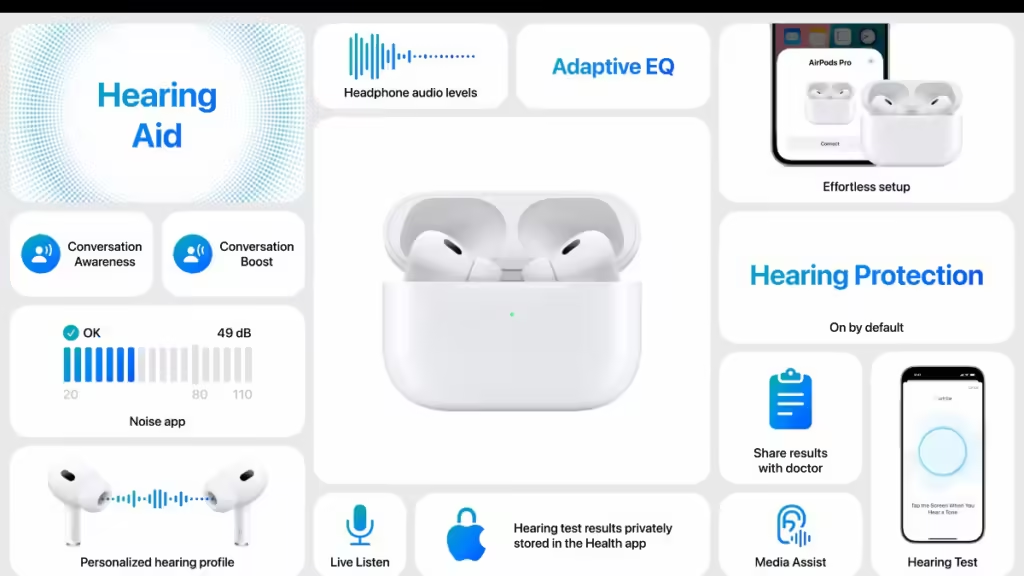The recent launch of the Apple Air Pod Pro 2 has stirred significant interest, particularly due to the introduction of a new hearing aid feature. As a tech enthusiast and early tester of this software, I dove deep into its functionality, performance, and overall usability. In this article, I’ll provide an in-depth look at what you can expect from the Air Pods Pro 2 hearing aid software, how it compares to traditional hearing aids, and my personal experience with the feature.
Understanding the AirPods Pro 2 Hearing Aid Feature
Apple has positioned the Apple Air Pod Pro 2 as not just a pair of premium wireless earbuds but also as a practical solution for those with hearing difficulties. This dual functionality is a game changer, allowing users to experience improved sound quality and enhanced audio accessibility without the need for specialized devices.
Key Features of the Hearing Aid Software
- Personalized Audio Profiles: The Apple Air Pod Pro 2 allows users to create personalized audio profiles tailored to their specific hearing needs. This feature is particularly beneficial for individuals with varying degrees of hearing loss.
- Adaptive Sound Control: This feature automatically adjusts audio settings based on your environment. Whether you’re in a noisy café or a quiet library, the Apple Air Pod Pro 2 optimizes sound to enhance speech clarity and reduce background noise.
- Transparency Mode: With this mode, users can hear their surroundings while still enjoying their audio content. It’s especially useful for conversations and situational awareness, providing a balance between immersion and interaction.
- Real-Time Conversation Boost: This functionality amplifies voices in conversations, making it easier to engage with others. By focusing on speech, it helps users follow discussions even in crowded spaces.
- Simple Setup and Integration: The Apple Air Pod Pro 2 integrates seamlessly with Apple devices, making setup quick and straightforward. Users can easily adjust settings through the iPhone’s accessibility menu.
Comparing AirPods Pro 2 to Traditional Hearing Aids

While the Apple AirPod Pro 2 offers impressive features, it’s essential to consider how they stack up against traditional hearing aids. Here are some points of comparison:
Cost
Traditional hearing aids can be quite expensive, often ranging from $1,500 to $4,000 per device. In contrast, Apple AirPod Pro 2 retail for around $249, making them a more accessible option for many users.
Functionality
While traditional hearing aids are specifically designed for hearing loss, the AirPods Pro 2 combines audio quality with additional features like music playback and voice assistant integration. However, traditional hearing aids often provide more precise tuning and can be customized to a greater extent based on audiologist recommendations.
Discretion and Design
The sleek design of the Air Pods Pro 2 makes them a discreet option for users who may feel self-conscious about wearing traditional hearing aids. The stylish appearance and wireless nature appeal to a younger demographic and those looking for a less clinical solution.
My Experience with the Air Pods Pro 2 Hearing Aid Software

Testing the AirPods Pro 2’s hearing aid features was an eye-opening experience. Here are some key observations from my hands-on experience:
User Interface and Setup
The setup process was seamless. After connecting the AirPods Pro 2 to my iPhone, I accessed the hearing aid settings via the Accessibility menu. The intuitive interface made it easy to adjust the sound profiles and toggle between modes. The personalized audio profiles feature allowed me to customize my listening experience, and I found the adjustments to be both quick and effective.
Sound Quality
The sound quality was outstanding. The adaptive sound control feature impressed me, as it effectively adjusted audio based on my environment. In a bustling café, for example, I noticed a marked improvement in speech clarity, while background noise faded into the background. This capability is a significant benefit for those who often find themselves in varying sound environments.
Real-Time Conversation Boost
This feature was particularly valuable during social gatherings. I tested it in a crowded room, and it truly amplified voices, making it easier to engage in conversations without straining to hear. This capability sets the AirPods Pro 2 apart, providing a level of functionality that traditional headphones simply cannot match.
Transparency Mode
Transparency mode worked flawlessly, allowing me to have conversations without removing the AirPods. This feature is a must-have for anyone who needs to balance audio enjoyment with situational awareness.
Limitations to Consider

While the AirPods Pro 2 offers remarkable features, there are some limitations to keep in mind:
- Not a Replacement for Professional Hearing Aids: While they provide significant benefits, they are not a substitute for professional hearing aids, especially for those with severe hearing loss.
- Battery Life: Using the hearing aid features may impact battery life, especially during long listening sessions. Users should keep this in mind, particularly when out for extended periods.
- Customization: While the audio profiles are customizable, they may not be as finely tuned as traditional hearing aids, which can be tailored specifically by audiologists to meet individual needs.
Conclusion
The Apple Air Pods Pro 2 with hearing aid software is a groundbreaking advancement for both audiophiles and those with hearing difficulties. While they may not replace traditional hearing aids for everyone, they offer an impressive alternative for many users looking for an affordable, stylish, and multifunctional solution. With features like personalized audio profiles, adaptive sound control, and real-time conversation boost, the Air Pods Pro 2 makes strides in making audio accessibility more inclusive. If you’re considering a hearing aid solution or simply want an upgrade to your audio experience, the AirPods Pro 2 is definitely worth exploring.

